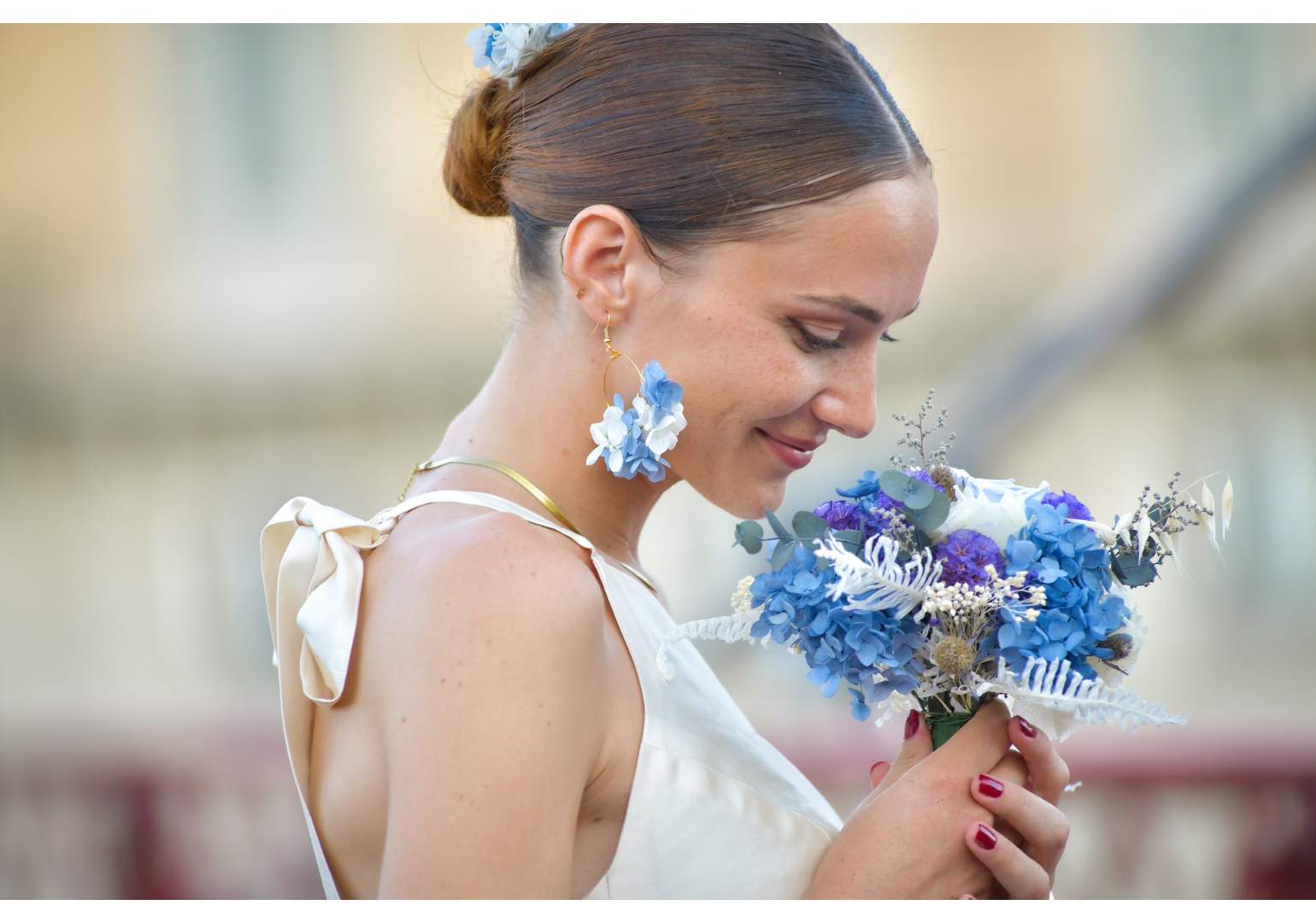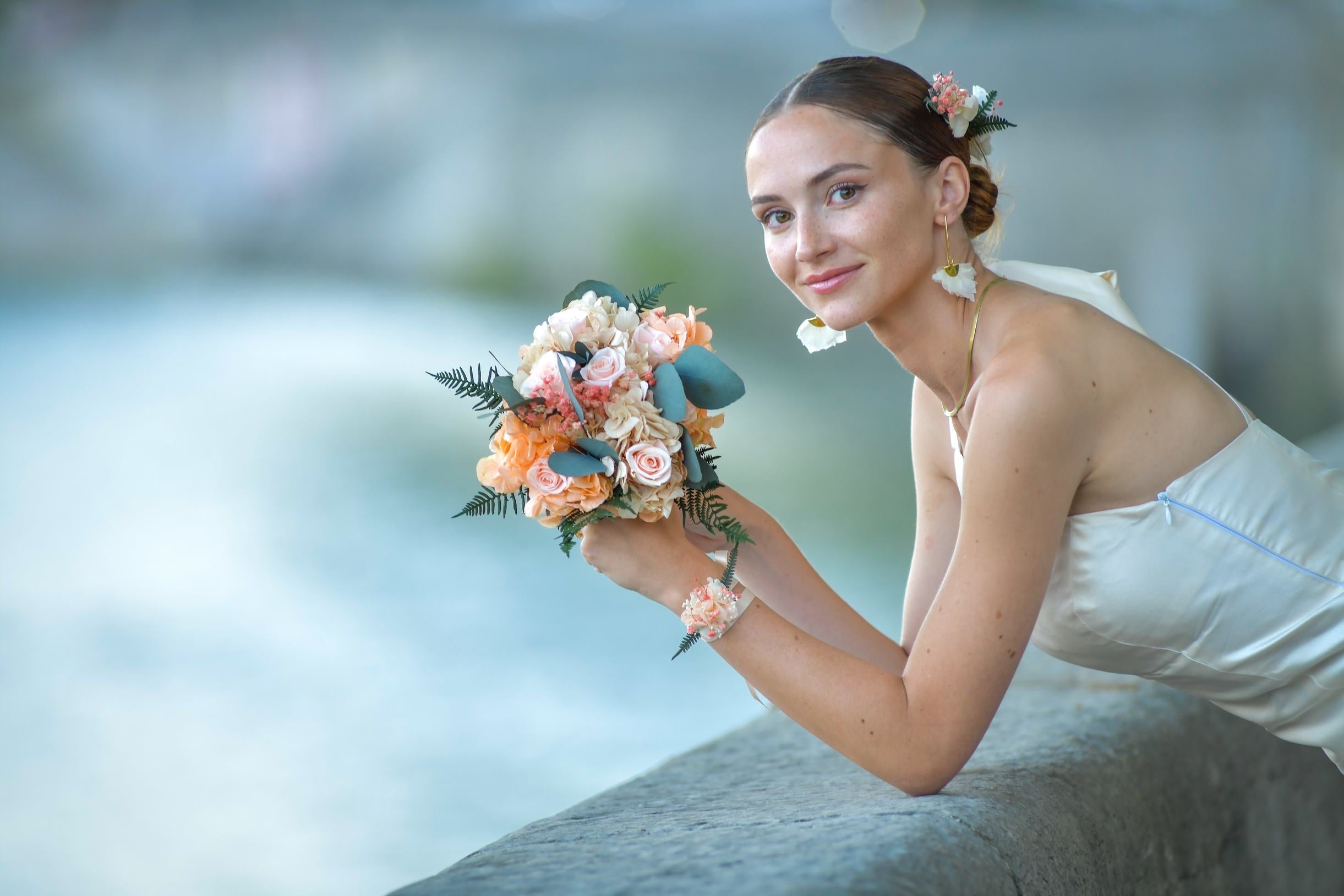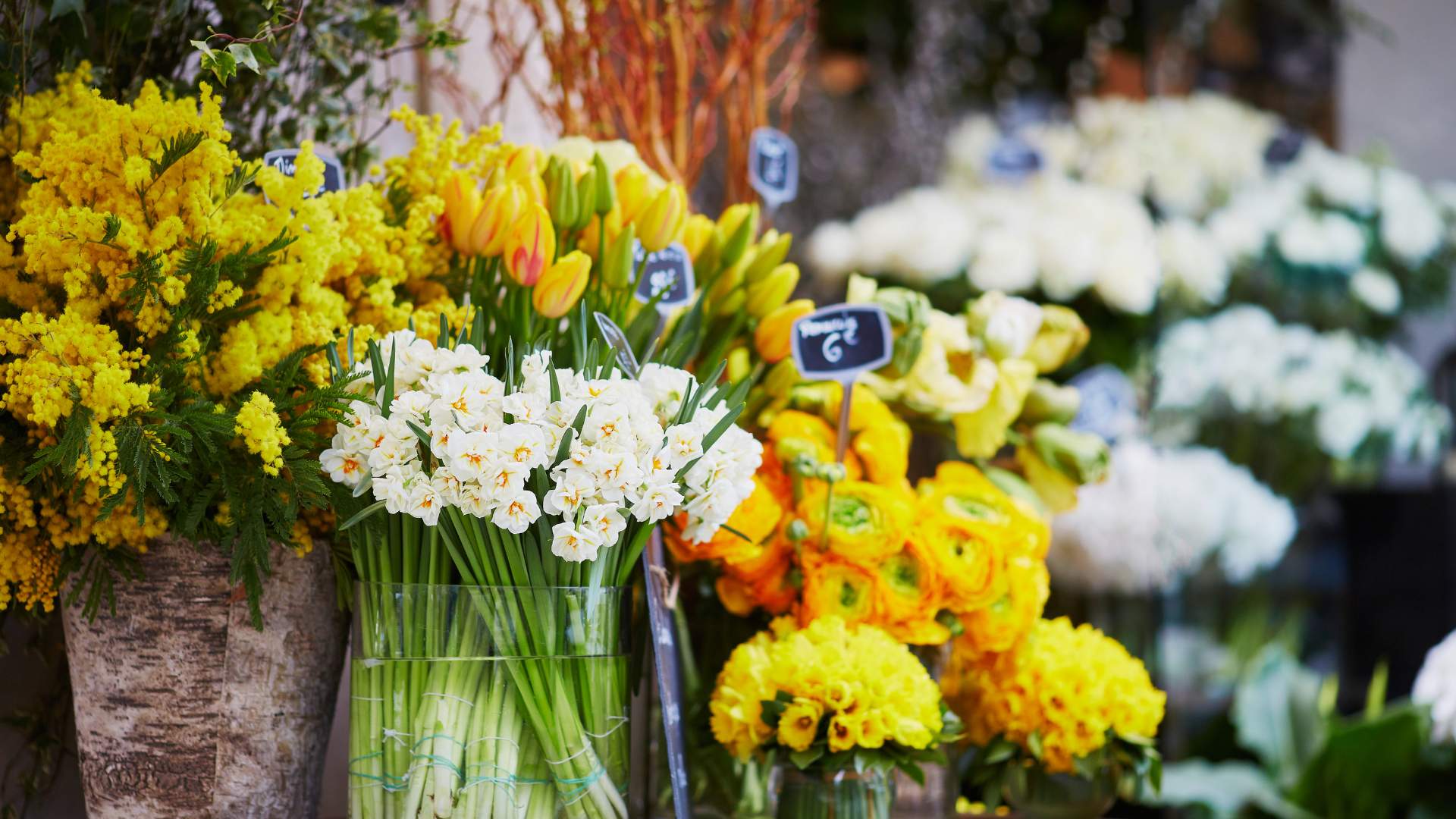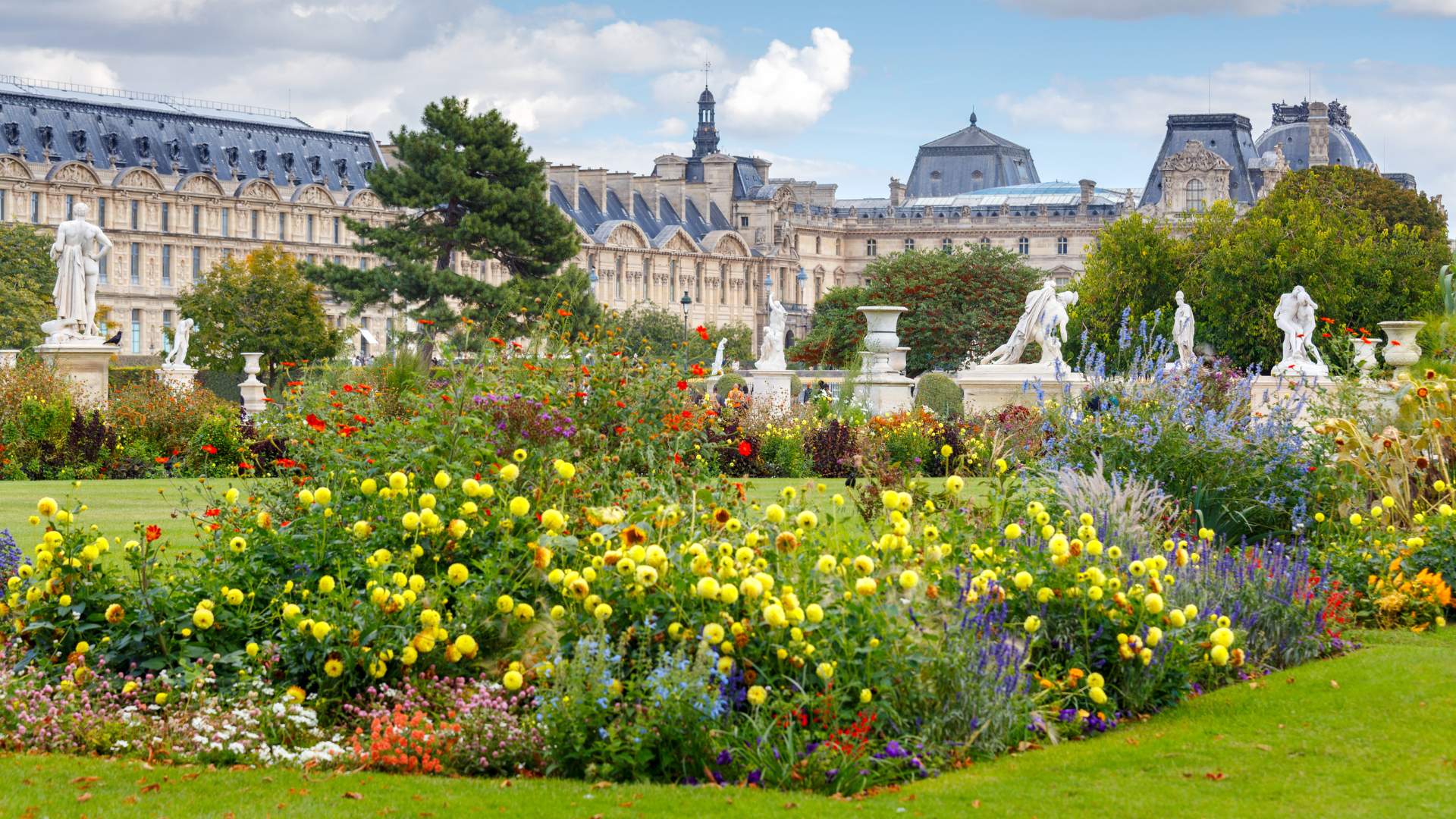Creating a bouquet for a wedding or any other special occasion isn't just about selecting the most beautiful flowers. The shape of the bouquet should be adapted to the body shape of the person who will wear it, favor seasonal flowers for an eco-friendly approach, understand the meaning of the flowers to avoid any faux pas, and ensure the freshness and practicality of the flowers. This article explores how to make the right choices by taking these different elements into account, helping you choose a bouquet that will perfectly complement your look while respecting your personal values and preferences.
Adapt the shape of the bouquet to the morphology
One of the most important aspects of choosing a bouquet is how it fits the wearer's body shape. The right choice not only enhances the overall appearance but also creates perfect aesthetic harmony. For tall and slim brides, a cascading bouquet, also known as a falling bouquet, is an ideal option. This type of bouquet offers a voluminous yet structured character, creating a sense of fluidity and elegance that pairs well with a straight or simple dress. The natural movement of the cascading bouquet adds a dimension of grace, transforming the bride's every step into a captivating visual dance.
The round bouquet, on the other hand, is a classic option that remains timeless. It easily adapts to various wedding themes and is ideal for slender figures. This bouquet, composed of flowers such as peonies, summer roses, or tulips, creates an elegant and sophisticated element. It can be customized with a mix of colors and textures to match any wedding theme, whether traditional or modern. On the other hand, airy bouquets add lightness and volume without weighing down the silhouette, making them ideal for those with curves. Flowers like lilies or gardenias add a touch of delicate poetry, balancing volume and lightness to highlight the bride's natural curves.
For petite brides, a short bouquet is best, as it doesn't overwhelm the silhouette. Small floral arrangements with forget-me-nots, anemones, or delicate flowers like baby's breath can work wonders, creating a refined and proportionate look. These bouquets, often lighter and more manageable, allow the bride to move freely while maintaining an elegant appearance. Choosing the shape of the bouquet according to the body shape ensures that every bride will feel comfortable and radiant on her wedding day.
Favor seasonal flowers
Opting for seasonal flowers has several major benefits. Not only does it reduce your carbon footprint, but it also means less water consumption and fewer pesticides, while generally being more economical. By choosing seasonal flowers, you're also supporting local producers and promoting a more sustainable economy. Additionally, seasonal flowers are often fresher and more resilient, ensuring a longer-lasting and more vibrant appearance.
In spring, flowers like peonies, lily of the valley, tulips, and anemones are ideal. These flowers often symbolize renewal and beauty, bringing a touch of freshness and vibrancy to bouquets. Peonies, for example, are known for their large, lush blooms and delicate hues, while tulips offer a vibrant and varied color palette.
In summer, choose sunflowers, summer roses, gerberas, and wild roses. Sunflowers, with their large yellow flowers, evoke warmth and sunlight, while summer roses bring timeless elegance. Gerberas, available in a variety of vibrant colors, add a cheerful and vibrant touch to floral arrangements.
Chrysanthemums and colchicums are ideal for autumn. These flowers, often associated with the harvest season, provide rich, warm hues that perfectly complement autumn colors. Chrysanthemums, in particular, are known for their long life and wide variety of shapes and colors.
In winter, options like iris and jasmine offer wonderful choices. Iris, with its elegant petals and deep colors, adds a touch of mystery and sophistication, while jasmine, with its captivating fragrance, evokes purity and delicacy. By choosing seasonal flowers, you not only ensure better quality and freshness, but you also make an environmentally friendly choice.
Meaning of Flowers
Each flower carries a specific meaning, so it's vital to know their language to avoid unwanted negative connotations during important events. Understanding the meaning of flowers allows you to convey subtle and personal messages through your bouquet. Carefully chosen flowers can tell a story, express emotions and wishes, and add an extra dimension to your celebration.
The lily, for example, symbolizes purity and nobility. It is a majestic flower that is ideal for weddings, representing values of virtue and grandeur. The magnolia, on the other hand, is associated with dignity and perseverance, symbolizing strength and inner beauty. Lily of the valley, with its small white bells, evokes newfound happiness and luck, making it a popular choice for bridal bouquets.
The peony is another flower with positive meaning, representing honor and wealth. Its lush blooms and vibrant colors make it an elegant and prestigious choice. However, it's best to avoid flowers like the black rose, which symbolizes mourning and sadness, or the marigold, which is associated with grief and worry. By understanding the meaning of flowers, you can create a bouquet that is not only aesthetically pleasing but also carries a positive and meaningful message.
Guarantee the freshness of flowers
Fresh flowers are crucial to ensure optimal visual impact and longevity. Fresh flowers have vibrant colors, firm petals, and a subtle fragrance. Using fresh flowers in your bouquet not only ensures an attractive appearance but also a pleasant sensory experience. Fresh flowers can also better withstand varying weather conditions, ensuring your bouquet remains beautiful throughout the event.
There are several tricks you can use to check the freshness of flowers. Look at the stems: they should be green and moist, a sign that they were recently cut and well hydrated. Dried or brownish stems indicate that the flowers have been cut for too long and are likely to wilt quickly. Touching the petals is also a good indicator: they should be sturdy and not dried out. Soft or wilted petals are signs of aging.
Smelling the flowers is another reliable method: a pleasant, subtle scent indicates freshness, while a dull or absent odor may signal that the flowers have lost their vibrancy. By taking these precautions, you can be sure that your bouquet will be composed of fresh flowers that will last throughout your special day, adding to the beauty and elegance of your event.
Practicality and personalization of the bouquet
A bouquet that's too heavy or cluttered with prickly plants can quickly become uncomfortable, especially on a day when you'll be constantly on the move. Choosing lightweight flowers like irises or lily of the valley to avoid wrist strain is a good idea. These flowers are not only beautiful, but they're also easy to handle and carry throughout the day. Avoid flowers with prickly stems or cover them carefully to avoid discomfort or injury.
Some flowers, like chrysanthemums or colchicums, can leave stains on clothing. Choose flowers that won't stain your outfit, especially if you're wearing a white or light-colored dress. Non-staining flowers are not only practical, but they also allow you to fully enjoy your day without worrying about potential damage.
Incorporating personal elements into your bouquet makes it unique and especially sentimental. You can include family jewelry, pieces of fabric with sentimental value, or decorative items like vintage buttons or small paper stars. These personal touches add an emotional dimension to your bouquet, transforming it into a symbol of your memories and values. By personalizing your bouquet, you create an accessory that is not only beautiful but also deeply meaningful.
Originality and use of a professional florist
For those looking to think outside the box, opt for original bouquets such as origami creations and artificial flowers.








